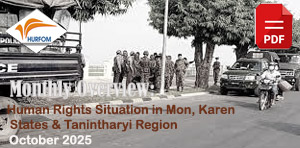Fleeing Prying Eyes; A Mothers Search for Safety
June 16, 2010
WCRP: Mi Cho*, a 40-year-old Mon woman, was born, married and gave birth to her six children in Alaesakhan village, Yebu Township, Tenasserim Division, southern Burma, however, because of increased instability throughout Mon state, she was forced to migrate to an Internally Displaced Person (IDP) area near the border of Thailand.
In January, three village militia soldiers unexpectedly paid a visit to Mi Cho’s husband. Thinking it was a friendly visit, her husband let the militia soldiers into his house without hesitation. Once inside the soldiers said, “We are here to arrest you,” not taking the charge seriously, because all previous encounters had been social, her husband did not resist the arrest. The soldiers then drew a knife and took him into custody.
Alaesakhan village is deemed a conflict area or “black zone” by the SPDC because of active splinters groups in the area. The SPDC mandates that all villages in conflict areas have militias, called Pyi-thu-sit, and villagers are seasonally forced to join through a lottery system. Village militia soldiers are used to fight armed splinter groups, arbitrarily arrest villagers, and patrol their village or surrounding areas
After the arrest, Mi Cho’s husband was given to SPDC Light Infantry Battalion (LIB) No. 282. He was then accused of being in contact with the Mon National Defense Army (MNDA), an active Mon splinter group in the area, and sending them food. “My husband has not contacted any splinter group. I don’t know why they arrested him,” Mi Cho proclaimed.
According to Kaowao, LIB No. 282 is a special battalion that guards the Yadana Gas Pipeline, and surrounding area. In the past, LIB No. 282 has been ambushed by the MNDA which is led by Major Jalon Taw who broke away from the New Mon State Party (NMSP) last year.
Mi Cho was not home during her husband’s abduction, but for weeks after, militia soldiers regularly visited her house in the middle of the night. During the visits, the soldiers would threaten her, frighten her family and accuse her of also supporting the Mon splinter group. Commonly, after the man of the family is killed or goes missing, their wife and children are the next targets.
Two weeks after the abduction, a SPDC soldier from LIB No. 282 informed Mi Cho that her husband was still alive, “If you want to see your husband, you can look for him in Tavoy town,” said the soldier. She however does not think her husband will ever be free.
By February, about a month after the abduction, Mi Cho could not handle the harassment any more. With no support or belongings, Mi Cho and her six children fled to Panan pain hakot village; an Internally Displaced Person (IDP) area within the NMSP controlled area of Mon State. Her youngest son was 6-months-old when they fled.
Upon arrival in Panan pain hakot, Mi Cho reconnected with Mi Khing, a neighbor from Alaesakhan village who had fled a couple weeks before Mi Cho. Mi Khing, had not yet secured a job, but she shared her food with the newly arrived family anyway. “When I saw her, I was so sad. She was so disappointed in her life and cried to me. They have many problems, now they live in a small hut made of bamboo, the neighbors help them but they cannot find enough food,” said Mi Khing.
Before Mi Cho fled, she worked at a small rubber and Betel nut plantation, and seasonally cut grass at a neighboring farm. In her old village she could earn enough to support her family, but jobs are scarce in the IDP area. Additionally, food, healthcare, education, land rights, employment and travel are a constant struggle.
Of her six children, the oldest is 16-years-old and the youngest is now 6-months-old. Her two middle children were in 2 standard and 0 standard at a Mon National school before they migrated. In the IDP area none of her children have the opportunity to attend school.
Mi Cho confided in Mi Khing, “I am so depressed, I am also afraid to go back to my village. I am worried they [SPDC soldiers] will kill us [if we return], but our property is there [in Alaesakhan village].” Mi Khing explained that SPDC Soldiers had a meeting on the 25 February and later that day they announced, to the village, that those who had fled or plan to flee are not allowed to return.
Mi Cho does not know how long her family will be able to survive in the IDP area or where she will head next.
Unfortunately, Mi Cho’s story is identical to so many in the IDP area. Over the past 4 months, 100s of residence from NMSP controlled areas have fled to IDP areas because of increased instability in Mon State and Tenasserim Division. Recently, because of the NMSP’s refusal to transform into a Border Guard Force (BGF) for the SPCD, mass fleeing has increased and rumors continue to circulate about the longevity of the NMSP’s 15-year-old ceasefire agreement with the SPDC.
According to WCRP field reporters, most villagers flee because of village militias (forced conscription and harassment), forced labor, accusations of contacting or supporting a splinter group, and death threats from SPDC soldiers.
* (Editors Note: All names have been changed for security reasons) *
Comments
Got something to say?
You must be logged in to post a comment.




















































